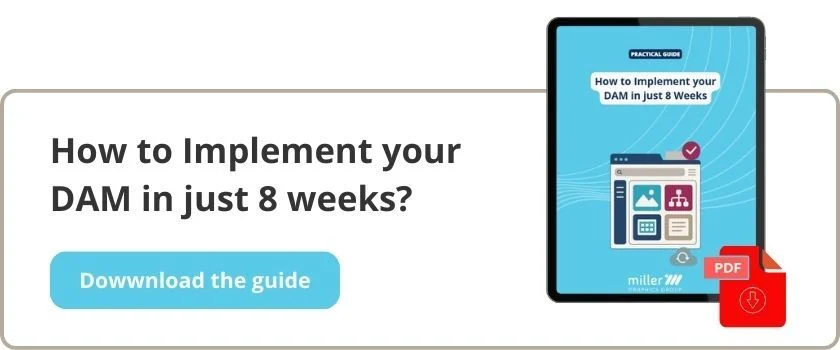Managing a plethora of digital assets can be overwhelming. That's where a robust digital asset management strategy comes into play, leveraging a digital asset management system to streamline your business processes.
This strategy encompasses a structured approach to organise, store, access, and share your valuable assets efficiently within your organisation. It's designed to enhance the value of your assets, simplify your processes, uphold your brand's consistency, and foster better collaboration among teams and partners—ultimately aligning with your business goals.
Understanding Digital Asset Management Strategy
What is a Digital Asset Management Strategy
Implementing a digital asset management strategy involves defining your goals, identifying stakeholders, auditing existing assets, creating a structured workflow, selecting an appropriate platform, and evaluating the outcomes. It also requires adherence to best practices and staying abreast of the latest developments in the field.
Far from being a one-off project, a DAM strategy is an ongoing process that requires regular review and refinement.
Benefits of a strong DAM Strategy
Employing a strong DAM strategy can yield numerous advantages for your organisation, including:
- Improved workflow efficiency: Automating and refining processes can save time, minimise mistakes, and boost productivity.
- Better asset utilisation: By ensuring digital assets are relevant, consistent, and current, a DAM strategy enhances their potential.
- Enhanced security: A DAM strategy safeguards digital assets against unauthorised use or loss, controls access, and sets permissions for different users or groups.
- Streamlined collaboration: By providing a unified source of truth for digital assets, a DAM strategy fosters improved communication and collaboration.
A well-crafted DAM strategy can positively influence various departments within a company, such as:
- Creative teams.
- Marketing teams.
- Sales teams.
Key Components of an Effective DAM Strategy
Understanding the importance and benefits of a digital asset management (DAM) strategy is just the beginning. To achieve long-term success, your strategy must include key components such as a single source of truth for asset organisation and classification, user roles and permissions tailored for authorised users, refined workflow and processes, and integration with other systems. Here's a closer look at each of these essential elements.
Asset Organisation and Classification
Quickly and easily finding digital assets is a common challenge. To overcome this, it's crucial to properly organise and classify your assets using metadata and taxonomy which enhance searchability, usability, and consistency of your assets. Here are some best practices:
- Adopt standard, consistent terms and formats for metadata and taxonomy.
- Engage stakeholders and users in defining metadata and taxonomy to meet their needs and preferences.
- Select a DAM solution that supports easy and automatic customisation and updating of metadata and taxonomy.
User Roles and Permissions
Securing digital assets while ensuring their efficient use involves defining user roles and permissions. These rules dictate who can view, edit, download, or share your assets, and the actions they are permitted to perform. Here are some best practices:
- Identify the different user types and their needs and responsibilities.
- Assign suitable access rights and restrictions based on user roles and asset types.
- Strike a balance between accessibility and security, allowing users enough freedom to access and use needed assets without excess.
Workflow and Processes
Streamlining the workflow and processes for managing digital assets, from creative files to marketing collaterals, is another critical challenge. Establishing workflows for asset creation, approval, distribution, and archiving is essential.
Defining workflows boosts efficiency, quality, and consistency, while preventing duplication and confusion. Best practices include:
- Charting current and desired workflows to identify inputs, outputs, roles, and actions for each step.
- Choosing a DAM system that automates and streamlines workflows.
- Regularly monitoring and adjusting workflows based on feedback, performance, and changes.
Integration with Other Systems
Integrating your DAM system with other platforms and tools, such as content management systems (CMS), product information management (PIM), and enterprise resource planning (ERP), poses a challenge yet offers significant benefits.
- Reducing manual work and errors by eliminating data duplication across systems.
- Ensuring consistency and accuracy through updated and synchronised data across platforms.
- Boosting efficiency and productivity by facilitating data access and use across systems.
Steps to Develop a Digital Asset Management Strategy
Creating a DAM strategy for your organisation, tailored for your digital library, is a complex task, but by following a systematic approach, informed by data-driven decisions, you can develop an effective DAM strategy.
Assessing Current Asset Management Practices
The journey begins with an audit of your existing digital asset management practices. This crucial step will give you a clear picture of how your digital assets are currently handled and how it can evolve.
To carry out this audit, consider using tools like surveys, interviews, focus groups, or analytics to collect data from stakeholders, users, and the assets themselves. Essential questions to ask include:
- The variety and volume of digital assets.
- How and where these assets are stored and organised.
- The current roles and responsibilities.
- Methods for searching, finding, and retrieving assets.
- Processes for creating, editing, and approving assets.
- Ways in which you distribute and share assets.
- Strategies for measuring and evaluating asset performance and value.
- Key pain points and frustrations with current practices.
- Goals and expectations for future asset management practices.
Setting Objectives and Goals
The next step involves defining clear, SMART (specific, measurable, achievable, relevant, and time-bound) objectives and goals for your DAM strategy. These should align with your overall organisational strategy and reflect the needs and expectations of your stakeholders and users. They should also tackle the challenges and opportunities identified during your audit.
Choosing the Right DAM System
Selecting a DAM system that aligns with your strategic goals and supports your key components is the third step. The right DAM software is a platform that centralises storage, organisation, access, and distribution of digital assets. With numerous options available, it's essential to choose wisely based on criteria like:
- The size and complexity of your digital asset collection.
- The types and formats of your digital assets.
- The diversity and number of your users, along with their roles and permissions.
- The workflows and processes needed to manage your digital assets.
- Required integrations with other systems and platforms.
- Your budget and available resources for the DAM project.
- The scalability and flexibility needed for future growth.
Comparing DAM systems based on these criteria, and seeking demos, trials, or references, will help you find the best fit for your organisation.
Implementing and Training
The final step is to roll out your DAM strategy, migrating digital assets to the new DAM system. For a smooth implementation, consider these best practices:
- Initiate a pilot project with a select group of users and assets to test the DAM system before a full-scale rollout.
- Offer training and onboarding sessions to help users get comfortable with the DAM system itself.
- Communicate the benefits and value of your DAM strategy.
- Encourage feedback and suggestions from users and stakeholders, making adjustments and improvements as needed.
Best Practices for Digital Asset Management
Regular Audits and Updates
Digital assets are dynamic, constantly evolving through new versions, updates, edits, or even expiration. To ensure your digital asset library remains current and relevant, conduct regular audits and updates. This involves reviewing your assets, metadata, and taxonomy periodically.
Here are some tips for regularly updating your assets:
- Opt for a DAM system with bulk edit capabilities for metadata and taxonomy.
- Select a DAM system that supports version control and history tracking.
- Choose a DAM system that notifies you when assets need reviewing, updating, or are nearing expiration.
Ensuring Compliance and Security
Digital assets often hold sensitive or confidential information, including personal data, intellectual property, or trade secrets, and may be governed by legal and regulatory frameworks like copyright, privacy, or accessibility laws.
To keep your digital assets compliant and secure, consider these best practices:
- Implement a DAM system with features to apply and enforce compliance and security policies.
- Use a DAM system that enables monitoring and auditing of digital asset access and usage.
- Ensure your DAM system has capabilities for backing up and restoring digital assets.
Encouraging User Engagement
The effectiveness of your digital asset management strategy is largely dependent on its adoption by users and stakeholders. To foster engagement, follow these best practices:
- Provide training and support to users and stakeholders.
- Communicate the benefits and value of your DAM system.
- Encourage feedback and suggestions from users and stakeholders, and make necessary improvements.
- Offer incentives and recognition.
Conclusion
This article has guided you through the essentials of adopting an optimal digital asset management (DAM) strategy and its significance for your organisation. We've outlined what constitutes a digital asset management strategy, identified its crucial elements, and provided steps to craft one tailored to your organisation’s needs.
Implementing a solid digital asset management strategy can elevate the value of your digital assets, enhance your operational workflows, preserve your brand's identity, and facilitate better collaboration among your teams and partners. Moreover, it's a pivotal tool in reaching your business objectives and enhancing your digital presence and performance.
To embrace our recommended digital asset management strategy effectively, selecting a DAM system that aligns with your strategic goals and supports the essential components is crucial.
Are you prepared to advance your digital asset management practices? Reach out to us today, and let us introduce you to ATOM, Miller Graphics’ DAM system.




